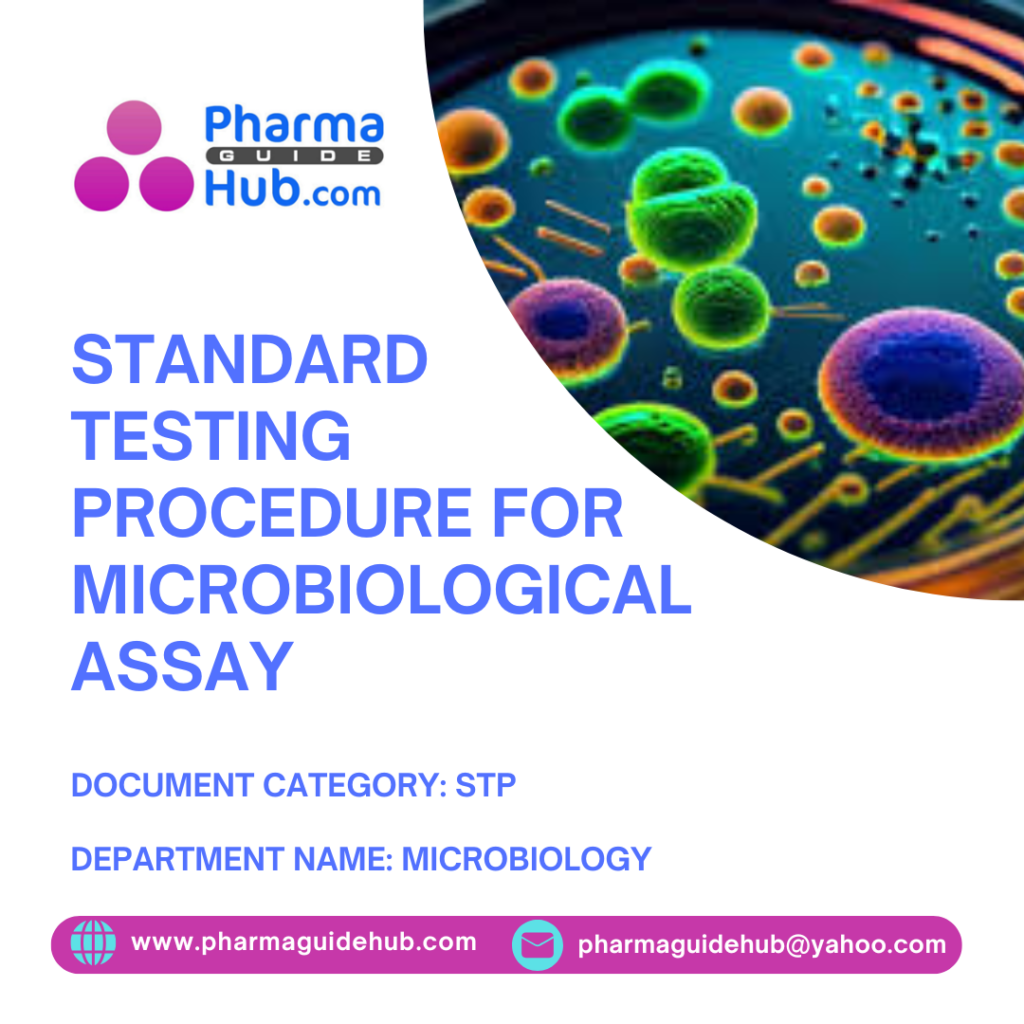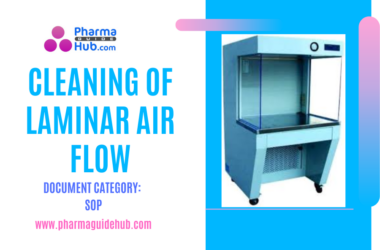
Objective:
To lay down standard Testing procedure For Microbiological Assay For Lactobacillus Species, Bacillus/ Lactic Acid Bacillus, Bifidobacterium Sp., Clostridium Sp., Streptococcus Sp., Saccharomyces Sp. & Blend Of Probiotics.
Applicability / Scope:
This STP is applicable to the Microbiology Section of {Company Name} {Location}.
Reference:
USP 43 <Chapter-64>: 2024
Responsibility:
It is the responsibility of the Jr. Microbiologist / Microbiologist/ Senior Microbiologist to follow this STP and Technical Manager / Quality Manager shall ensure implementation.
Principle:
To determine the number of living bacteria in a culture it is necessary to perform what is known as viable count. In this method an aliquot of the sample is suitable diluted, mixed with agar medium and incubated. Viable colonies appeared in the medium are counted.
Requirements:
Equipment:
- Weigh Balance
- pH Meter
- Autoclave
- Water bath
- Laminar Air Flow
- Biosafety Cabinet
- Micropipette
- Incubator
- BOD Incubator
- Colony Counter
- Microscope
Glassware/Accessories:
- Conical Flask / bottle
- Conical Flask / bottle
- Test Tube- 25ml
- Micropipette tips
- Loop
- Glass Beaker
- Petri Plate- 90mm
Media:
Specific medium Incubation conditions given below:
| S. No. | Test culture | Specific medium | Incubation conditions |
| 1. | Lactobacillus casei | PNY Medium (M835)/ Lactobacilli Broth (M368)/ Lactobacillus MRS Agar (M641) | Incubation at 30-35°C or 37°C for 18-72 hours |
| 2. | Lactobacillus leichmannii | PNY Medium (M835)/ Lactobacilli Broth (M368)/ Lactobacillus MRS Agar (M641) | Incubation at 30-35°C or 37°C for 18-72 hours |
| 3. | Lactobacillus plantarum | PNY Medium (M835) | Incubation at 30-35°C or 37°C for 18-72 hours |
| 4. | Lactobacillus rhamnosus | PNY Medium (M835)/ Lactobacilli Broth (M368)/ Lactobacillus MRS Agar (M641) | Incubation at 30-35°C or 37°C for 18-72 hours |
| 5. | Lactic acid bacillus | Glucose Yeast Extract Agar (M963) | Incubation at 30-35°C or 37°C for 18-72 hours |
| 6. | Bacillus coagulans | Lactobacillus MRS Agar (M641) | Incubation at 30-35°C or 37°C for 18-72 hours |
| 7. | Lactobacillus sp. | PNY Medium (M835)/ Lactobacilli Broth (M368)/ Lactobacillus MRS Agar (M641) | Incubation at 30-35°C or 37°C for 18-72 hours |
| 8. | Bifidobacterium sp. | Lactobacilli Broth (HiMedia M368)/ Bifidobacterium Agar (M1396) | 72-96h, 37°C, Incubate under anaerobic condition |
| 9. | Clostridium sp. | Reinforced Clostridial Agar (HiMedia M154) | 24-48h, 37°C |
| 10. | Streptococcus sp. | Lactobacilli Broth (HiMedia M368) | 48 to 72h at 37°C, Pin point colony |
| 11. | Saccharomyces sp. | Sabouraud chloramphenicol Agar (HiMedia M1067) / YPD Agar (G038) | Incubation at 25°C or 30°C for 48-72 h. |
| 12 | Blend of probiotics | HiMedia M641/ M368 | 24-72 h, 37°C Pin point colony |
Procedure / Methodology:
Diluent:
Maximum Recovery Diluent: Weight 1.0 g of peptone, 0.85 g of NaCl, 0.05 g of tween 80 and add into dried conical flask. Add 90 ml of PW water. Allow it to dissolve properly by gentle shaking or on magnetic stirrer. Adjust the pH to 6.0 with NaOH, make the volume 100 ml.
Saline solution (0.9%): To make a saline solution, 9.0 g of NaCl is dissolved in 1000 ml of distilled water and autoclaved at 121°C for 15 min (pH: 7.0 ±0.1).
Sample Preparation:
Sample Quantity:For raw material 1gm sample is taken, for tablet, capsule quantity is equivalent to average weight and average fills respectively, for dry syrup quantity equivalent to claim on the sample.
Weigh accurate as specified above.
Transfer into homogenizing flask containing 100 ml sterile solution and homogenize for 7 to 10 minutes.
This makes test solution of 1:100 dilutions.
Mix well the test and dilute if further stepwise through a series of test tubes containing 9 ml of sterile solution.
The final stock dilution is estimated to procedure 30 to 300 colonies per plates after incubation.
Allow standing the final diluted tube in a water bath at 75⁰C for 30 minutes (Heat shock), cool immediately to about 45⁰c pipette accurately 1ml from heat stock solution and add into each of five sterile Petri plates.
Add about 15 ml of sterile agar medium.
Incubate the plates as per Above Table-1, in inverted position and count the no. of colonies in each colony.
Calculation: Avg. No. of Colonies X Dilution factor X Average Weight
Microscopic observation:
Herein; 1 g of culture is dissolved in 10 ml of the distilled water. To this, 1μl of culture is taken and slide is prepared. The slide is further observed under microscope.
Morphological Characteristics given below:
| S.No | Cultures | Morphology |
| 1. | Lactobacillus | Lactobacillus are gram positive, non- spore forming, rod shaped. |
| 2. | Streptococcus | Streptococcus are gram positive, oval shaped and appear as long and short Chains. |
| 3. | Saccharomyces | Saccharomyces are gram positive, unicellular, globose, and ellipsoid to elongate in shape. |
| 4. | Bacillus | Bacillus are spore forming, rod shaped and gram positive. |
| 5. | Bifidobacterium | Bifidobacterium are gram-positive pleomorphic rods, ranging from uniform to branched, bifurcated Y and V forms, spatulate or club shaped |
Calibration / Validation:
- Internal Calibration: NA
- External Calibration: NA
- Validation: NA
Precaution:
The experiments must be conducted as per above mentioned recommended culture conditions to avoid any extrinsic microbial contamination of the product (blend /culture) to be examined.
The precautionary measures should be such that it does not affect the microbial culture that is to be revealed.
Distribution:
Master Copy : Quality Assurance Documentation Cell
Controlled Copy : Microbiology Department
Abbreviations:
| Short Form | Full Form |
| STP | Standard Testing procedure |
| QA | Quality Assurance |
| S. | Serial |
| No. | Number |
| ECL | Enviro Calibration Lab |
| Jr. | Junior |
| NA | Not Applicable |
| Amend. | Amendment |
| No. | Number |
| AHU | Air Handling Unit |
| MLT | Microbial Limit Test |
| Sp. | Species |
Related Documents:
| S. No. | Document / Record No. | Document / Record Detail |
| NA | NA | NA |
Related Formats:
| S. No. | Document / Record No. | Document / Record Detail | Format |
| NA | NA | NA | NA |
Document Change History:
| S. No. | Issue No. / Revision No. & Date | Supersedes Issue No. / Revision No. & Date | Reason for Revision/Changes |
| NA | NA | NA | NA |


very nice , very nicely explained